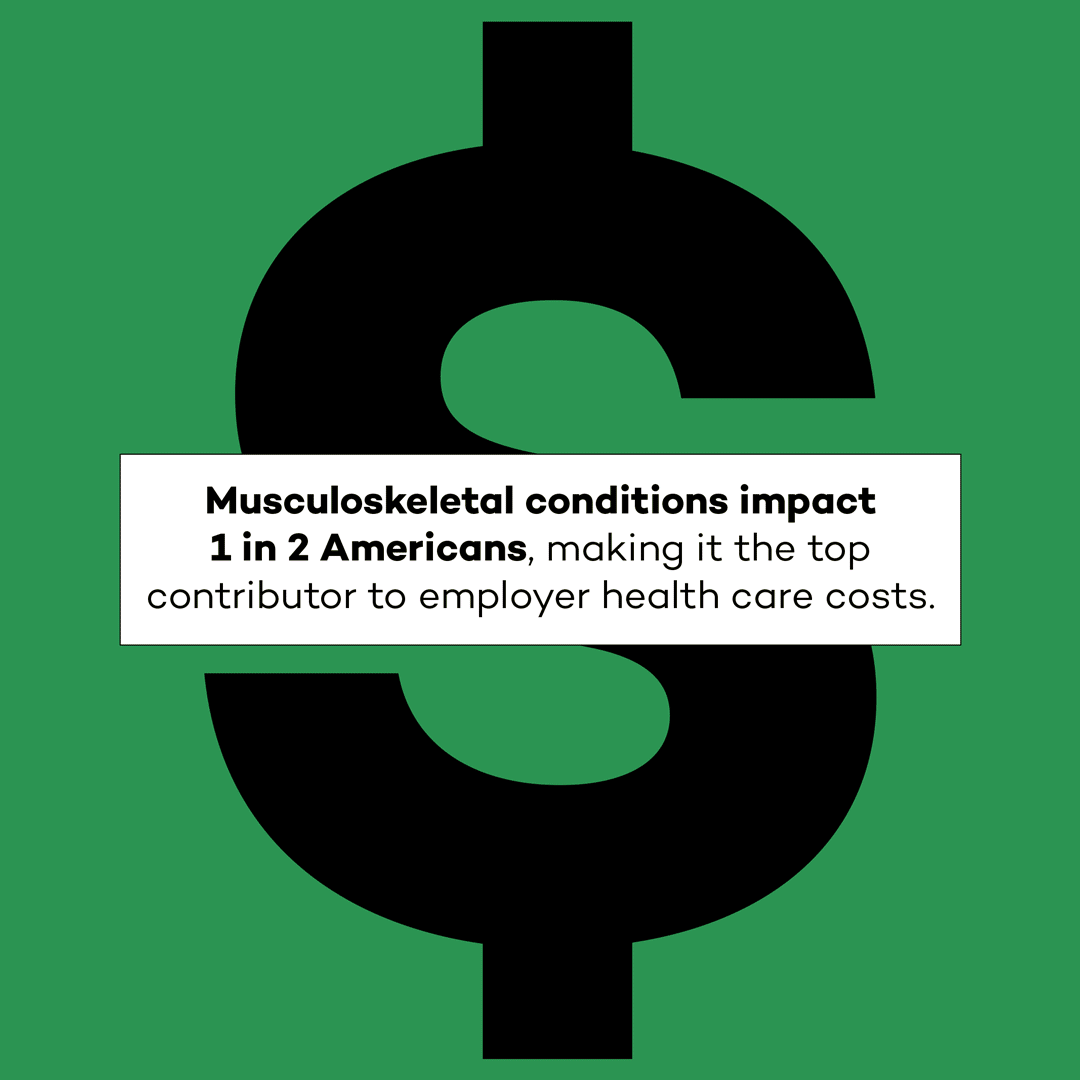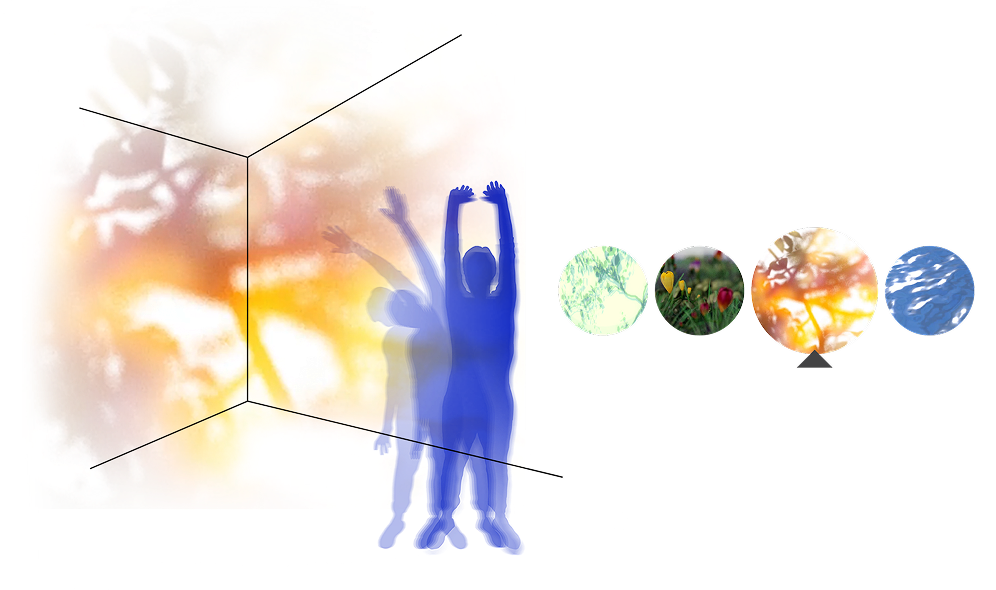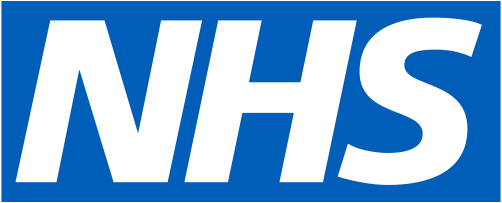
How Microbreaks can Reduce The Cost of Musculoskeletal Pain.
We’ve all felt it: the crick in your neck, aching back, and tired wrists you feel throughout the workday, actually has a name: musculoskeletal pain. Musculoskeletal pain is incredibly common, but also very preventable and treatable. It is never too late to start making strides towards a less painful day.

What is musculoskeletal pain?
Musculoskeletal conditions affect the bones, muscles, joints and certain connective tissues and these conditions are felt by over half of Americans.5,6 The majority of Americans (80%) spend their workday at a desk, staying seated for 78% of their working day placing full-time office workers at increased risk for cardiovascular and metabolic morbidity and mortality.1,2,4 Beyond just working hours, people sit an average of 12.3 hours of a 16 hour day.3
All of this sitting does not go without consequence; musculoskeletal conditions:
- Affect approximately 1.71 billion people worldwide.21
- Are the leading contributors to disability worldwide, with low back pain being the single leading cause of disability in 160 countries.21
- Significantly limit mobility and dexterity, leading to early retirement from work, lower levels of well-being and reduced ability to participate in society.21
Some of the most common musculoskeletal conditions (carpal tunnel syndrome and arthritis) are compounded by daily, repetitive actions like typing and sitting for prolonged periods of time.5 Tasks performed by desk-based workers are characterized by physical stress due to prolonged time in a seated position and repetitive movements. Mental stress aggravates, and in some cases can cause, musculoskeletal discomfort.7
Those with chronic musculoskeletal pain report significantly more symptoms of anxiety, depression, fatigue, and insomnia than patients without chronic musculoskeletal pain.20 Thus, employees are suffering not only from pain and the monetary costs of treating these conditions, but also psychological distress.
How microbreaks can help reduce musculoskeletal pain.
So, how can we be alleviating, and even preventing these conditions?
These negative effects occur even if you exercise daily, the only way to truly prevent or reduce them, is to spend less prolonged time sitting.
It can be incredibly easy to fall into the grind of work and everyday life and forget what our body craves most: movement. It can also be easy to forget that what we do today affects our bodies tomorrow and well into the future. But it is never too late to improve or change our habits for the better; our bodies have a miraculous ability to change and improve, even with small positive interventions.
Adding just a few microbreaks to your day can help reduce the amount of musculoskeletal pain you feel (especially in the neck, wrists, shoulders, and upper back), as well as the number of places you feel it.8,9
- Otolaryngologists who took microbreaks every 20-40 minutes during surgery experienced improved pain scores in neck, shoulders, hands, and lower back pain.22
- A work–rest schedule including 1 minute microbreaks can significantly reduce muscle fatigue without affecting work productivity.23
- Those taking stretching microbreaks every 30 minutes reported the greatest reduction in musculoskeletal discomfort compared to sedentary breaks.24
If you’re lucky enough to not suffer this pain, you can use microbreaks to break up sedentary behavior and help you ensure you never do, as well as improve flexibility and overall sense of well-being.23
The price you pay for sitting: the healthcare costs of musculoskeletal pain.
The cost of musculoskeletal pain is astronomical for organizations, as well as its employees, but much of it could be prevented with a simple daily change that can happen in just 2 minute moments.
The consequences of this amount of time spent sitting is faced by both employers and employees, with organizations facing exorbitant medical costs and employees facing pain, surgeries, and stress. Instead of focusing solely on treatment, we should also be allocating resources towards prevention.
Employers spend $353 billion annually on treatments aimed at helping their employees with musculoskeletal conditions and 75% of employers rank musculoskeletal conditions among the top 2 health conditions (and rising) driving their costs.10,11,12 The $353 billion organizations spend annually on musculoskeletal pain treatments accounts for nearly 15% of their total medical costs.13 With musculoskeletal conditions impacting 1 in 2 Americans, it is the top contributor to employer health care costs at over $52 per member per month.5
More specifically,
- Each employee with arthritis adds $8,919 in annual health care costs.14
- Each employee with rheumatoid arthritis adds about $7,500 in annual health care costs.15
- Those who suffer from osteoarthritis (a common cause of knee pain) can cost businesses $7,707 more in total annual healthcare costs.16
- The medical and pharmacy costs for those with low back pain are around $2,400 higher compared to other employees.17
And, in a study of 192 countries and territories, 7.3 million years lived with disability and $180.7 billion total costs associated with musculoskeletal disorders were attributed to high Body Mass Index, often caused by sedentary behavior.18
Employers spend $353 billion annually on treatments for musculoskeletal conditions and 75% of employers rank musculoskeletal conditions among the top 2 health conditions (and rising) driving their costs.10,11,12
Organizations can save money with microbreaks.
Musculoskeletal pain and injuries are incredibly costly to employees in terms of time spent suffering, as well as their own out of pocket medical costs. And when employers are facing a hurt of their own funding healthcare costs for pain prevention, surgeries, physical therapy, and the cognitive cost of sitting still, why are we not taking the tiniest fraction of the $353 billion spent on musculoskeletal pain treatments alone to prevent these conditions? To prevent employee pain and suffering and out of pocket costs. To prevent the number of workdays employees are using to recover from this pain, that they could instead use to spend time in nature, with their children, and fully resting and recharging. To prevent the amount of productivity lost due to the mental and physical pain that comes with musculoskeletal conditions.
Imagine a simple intervention that could help both employees and employers. 36% of musculoskeletal surgeries are unnecessary, and employers stand to save at least $90 billion per year if employees choose pain-relief methods like physical therapy over surgery.19 Now imagine the savings that could occur if you could prevent some of the injuries altogether through microbreaks.
Breakthru invites you to resolve to spend less time sitting and more time moving, even (and especially) during the workday! Make your mind and body health a priority this year by committing to more microbreaks, more time spent in nature, and more time celebrating the beauty of what our bodies can do. We promise, your future self will thank you.
- Gremaud, A. L., Carr, L. J., Simmering, J. E., Evans, N. J., Cremer, J. F., Segre, A. M., Polgreen, L. A., & Polgreen, P. M. (2018). Gamifying accelerometer use increases physical activity levels of sedentary office workers. Journal of the American Heart Association, 7(13), e007735. https://doi.org/10.1161/JAHA.117.007735
- Huang, Y., Xu, S., Hua, J., Zhu, D., Liu, C., Hu, Y., & Chen, Z. (2020). Emotional responses and coping strategies in nurses and nursing students during COVID-19 outbreak: A comparative study. PLOS ONE, 15(8), e0237303. https://doi.org/10.1371/journal.pone.0237303
- Scutti, S. (2017, September 12). Yes, sitting too long can kill you, even if you exercise. CNN Health. Retrieved from https://edition.cnn.com/2017/09/11/health/sitting-increases-risk-of-death-study/index.html
- Young, D. R., Hivert, M. F., Alhassan, S., Camhi, S. M., Ferguson, J. F., Katzmarzyk, P. T., Lewis, C. E., Owen, N., Perry, C. K., Siddique, J., & Yong, C. M. (2016). Sedentary behavior and cardiovascular morbidity and mortality: A science advisory from the American Heart Association. Circulation, 134(13), e262-e279. https://doi.org/10.1161/CIR.0000000000000440
- UnitedHealthcare. (2024, March 22). Musculoskeletal conditions drive employer health care spend. Retrieved from https://www.uhc.com/agents-brokers/employer-sponsored-plans/news-strategies/musculoskeletal-conditions-drive-spend
- United States Bone and Joint Initiative. (n.d.). Fast facts: Musculoskeletal conditions. Retrieved from https://www.boneandjointburden.org
- Lacaze, D. H. de C., Sacco, I. de C. N., Rocha, L. E., Pereira, C. A. de B., & Casarotto, R. A. (2010). Stretching and joint mobilization exercises reduce call-center operators' musculoskeletal discomfort and fatigue. Clinics, 65(7), 649-656. https://doi.org/10.1590/S1807-59322010000700003
- Arippa, F., Nguyen, A., Pau, M., & Harris-Adamson, C. (2023). Movement Behavior and Health Outcomes among Sedentary Adults: A Cross-Sectional Study. International Journal of Environmental Research & Public Health, 20(5), 4668. https://doi.org/10.3390/ijerph20054668
- Grünwald, J. A., & Licka, T. F. (2023). Health Promotion for Students of Veterinary Medicine: A Preliminary Study on Active Microbreaks and Ergonomics Education. Animals (2076-2615), 13(10), 1641. https://doi.org/10.3390/ani13101641
- Demyan, D. (2023, April 21). How do you use data to reduce musculoskeletal (MSK) costs on your health plan? Roundstone Insurance. Retrieved from https://www.roundstoneinsurance.com
- Castlight. (2022, April). 2022 Castlight Workforce Health Index. Retrieved from https://www.castlighthealth.com
- Business Group on Health. (2023, August 22). 2024 Large Employer Health Care Strategy Survey: Executive Summary. Retrieved from https://www.businessgrouphealth.org/en/resources/2024-large-employer-health-care-strategy-survey-executive-summary
- Demyan, D. (2023, April 21). How do you use data to reduce musculoskeletal (MSK) costs on your health plan? Roundstone Insurance. Retrieved from https://www.roundstoneinsurance.com
- Ortaliza, J., Amin, K., Cox, C., Michaud, J., & Kates, J. (2021, November 12). COVID-19 mortality preventable by vaccines. Peterson-KFF Health System Tracker. Retrieved from https://www.healthsystemtracker.org/brief/covid19-and-other-leading-causes-of-death-in-the-us/
- Integrated Benefits Institute. (2018, February). Health and productivity impact of chronic conditions: Rheumatoid arthritis. Retrieved from https://www.ibiweb.org/resources/the-health-and-productivity-impact-of-chronic-conditions-report-rheumatoid-arthritis
- Bedenbaugh, A. V., Bonafede, M., Marchlewicz, E. H., Lee, V., & Tambiah, J. (2021). Real-world health care resource utilization and costs among US patients with knee osteoarthritis compared with controls. ClinicoEconomics and Outcomes Research, 13, 421-435. https://doi.org/10.2147/CEOR.S302289
- Integrated Benefits Institute. (2019, September). Health and productivity impact of chronic conditions: Back pain. Retrieved June 10, 2024, from https://www.ibiweb.org/resources/the-health-and-productivity-impact-of-chronic-conditions-report-back-pain
- Del Río, F., Zitko, P., Santis, R., Babul, M., & Santis, F. (2023). Loss of health state utilities attributable to obesity. Value in Health Regional Issues, 36, 92-97. https://doi.org/10.1016/j.vhri.2023.02.007
- Hafner, L. (2023, July 21). 36% of MSK surgeries are unnecessary, costing the workforce $90B. Employee Benefit News. Retrieved from https://www.benefitnews.com/news/36-of-msk-surgeries-are-unnecessary-costing-the-workforce-90b
- Garnæs, K.K., Mørkved, S., Tønne, T. et al. Mental health among patients with chronic musculoskeletal pain and its relation to number of pain sites and pain intensity, a cross-sectional study among primary health care patients. BMC Musculoskelet Disord 23, 1115 (2022). https://doi.org/10.1186/s12891-022-06051-9
- World Health Organization. (2022, July 14). Musculoskeletal conditions. Retrieved from https://www.who.int/news-room/fact-sheets/detail/musculoskeletal-conditions
- Elzomor, A., Tunkel, A., Lee, E., Jaamour, F., Davidson, L., Shaver, T. B., Niermeyer, W., Benito, D., Cole, K., & Zapanta, P. (2022). Intraoperative stretching microbreaks reduce surgery-related musculoskeletal pain in otolaryngologists. American Journal of Otolaryngology, 43(6), 103594. https://doi.org/10.1016/j.amjoto.2022.103594
- Beltran Martinez, K., Nazarahari, M., & Rouhani, H. (2023). Breaking the Fatigue Cycle: Investigating the Effect of Work-Rest Schedules on Muscle Fatigue in Material Handling Jobs. Sensors, 23(24), 9670. https://doi.org/10.3390/s23249670
- Radwan, A., Barnes, L., DeResh, R., Englund, C., & Gribanoff, S. (2022). Effects of active microbreaks on the physical and mental well-being of office workers: A systematic review. Cogent Engineering, 9(1). https://doi.org/10.1080/23311916.2022.2026206
Breakthru in the World
Request a demo to learn how teams stay sharper, healthier, and more connected with Breakthru
See how science-backed, 2-minute microbreaks can boost focus, motivation, and resilience for your organization.

Join the
45,000+
corporations, educational
communities, and non-profits
worldwide using Breakthru.















